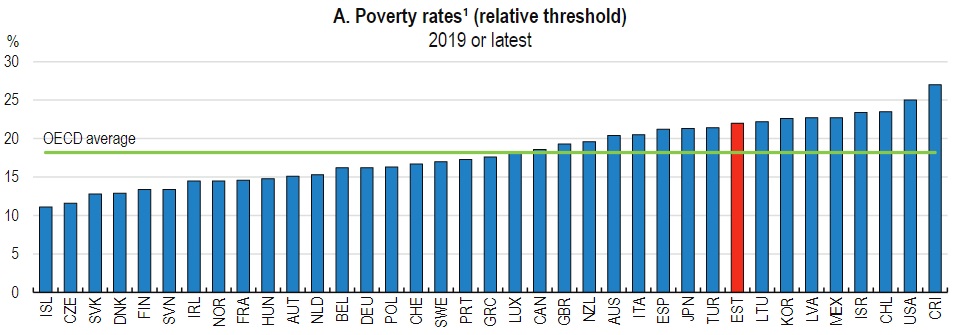The past two days have featured columns about Estonia, with the first one focusing on the nation’s impressive rebound after decades of communist enslavement and the second one criticizing the Organization for Economic Cooperation and Development (OECD) for suggesting tax-and-spend policies that would undermine the country’s prosperity.
Both columns used data from a recent OECD report. Today, I’m going to write a third column using data from that report, but I won’t be focusing on Estonia. Instead, I want to address the OECD’s ongoing efforts to promote redistribution by lying about poverty.
Here’s a chart that ostensibly shows poverty rates in various member nations.

Any sentient person should immediately recognize that the chart is garbage. Notice, for instance, that that United States supposedly has the second-highest poverty rate among OECD nations.
Yet does any rational person actually think poverty is a bigger problem in America than it is in Mexico or Turkey? Or Italy, Hungary, or Greece?
Of course not. Heck, poor people in the United States often have incomes that are equal to or higher than average incomes in other nations.
So what’s going on?
Well, if you read the fine print, you’ll find that the chart doesn’t actually measure poverty. At all.
Instead, it’s a measure of income distribution. The OECD’s bureaucrats have decided that anybody who makes less than 60 percent of a nation’s average income is poor.
This is an absurd approach.
Heck, the OECD’s dishonest approach would show that there’s almost no poverty in the world’s poorest nations, such as North Korea, Haiti, Cuba, and Congo. After all, if almost everyone is equally destitute, then almost nobody will be below 60 percent of the median.
Here’s another example that exposes the OECD’s scam. Imagine that everyone in the United Sates suddenly had three times as much income as today. That would seem like great news, especially for lower-income Americans. Yet based on the OECD’s dishonest approach, the poverty rate would not change.
So why is the OECD publishing nonsensical and dishonest numbers?
I answered that question back in 2012.
The main thing to understand, though, is that this new approach is part of an ideological campaign to promote bigger government and more redistribution. Which is very much consistent with the OECD’s overall agenda.
The fact that this type of agenda hurts poor people doesn’t seem to bother our friends on the left. So long as rich people are hurt even more, that’s a good thing from their perspective.
Remember, they are motivated by equality of outcomes.
Good people, by contrast, seek policies that enable poor people to improve their lives (as captured by the Eighth Theorem of Government).
P.S. Here’s my collection of other hucksters that peddle dishonest poverty data.
P.P.S. Here’s a story from Sweden about what happens when the ideology of equality produces very bizarre outcomes.
———
Image credit: OECD Organisation for Economic Co-operation and Development | CC BY-NC-ND 2.0.


